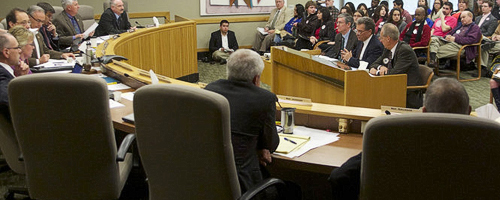In an attempt to increase awareness, members of the Oregon State Board of Higher Education are forming a committee for the prevention of sexual assault crimes in Oregon universities.
Board of Higher Ed forms new sexual assault committee
In an attempt to increase awareness, members of the Oregon State Board of Higher Education are forming a committee for the prevention of sexual assault crimes in Oregon universities.
The committee, called the Oversight Committee on Sexual Assault, will begin its campaign by distributing a survey designed to determine the status of sexual assault awareness to each of the seven Oregon University System (OUS) campuses, according to Henry Lorenzen, president of the Board of Higher Education. Lorenzen also said that the committee is likely to hold training seminars and increase the severity of penalties against sexual assault offenders caught on OUS campuses.
The committee is still in the early stages of development and could be functional as early as September of this year, according to Di Saunders, director of communications for the OUS.
The committee chair will be Dr. Antone Van Vliet, a former professor at Oregon State University and current member of the State Board of Higher Education.
Lorenzen said he chose Van Vliet, who taught at Oregon State University for over 35 years, for the chairman position because he has been active in deterring sexual assault on campus throughout his career.
“Tony’s been involved with this sort of thing before, and it’s essential that the chair of the Oversight Committee is acclimated to the sensitivity and determination that surrounds sexual assault on campus,” Lorenzen said. “I look forward to the benefits of having someone who is so well rooted in Oregon’s collegiate history.”
Lorenzen said that he got the idea to start the Oversight Committee following discussions with U.S. Attorney Patrick Meehan and learning of the Jeanne Clery Act, a federal law that requires college campuses to disclose annual reports about criminal activity on campus.
Jay Kenton, vice chancellor for OUS, said that the idea for the committee began formulating among OUS administrators and State Board members earlier this year. Hardy Myers, attorney general of Oregon, is involved with the committee’s formulation as well, according to Kenton.
“There are any number of situations in which students may be taken advantage of that need to be prevented,” said Kenton. “The committee will provide heightened prevention systems, easily accessible counseling for victims and stringent sanctions for perpetrators…all things that will be facilitated by the attorney general’s involvement.”
Lorenzen said that he is still deliberating over the committee’s positions and who will fill them, but he hopes to fill all committee positions over the next six weeks. Lorenzen also said he will be on the committee’s finalized staff, though his term as president of the State Board of Higher Education ends this fall.
“I understood [after discussions with Meeham] that there is a movement across the nation and the state to deal with sexual assault in a very comprehensive manner,” Lorenzen said. “The committee will be a mechanism to prevent sexual assault on campus and educate students on what needs to happen in order to protect themselves.”
Lorenzen said that a recent study conducted by the National Institute of Justice, a division of the U.S. Department of Justice, found that only eight campuses nationwide have exemplary sexual assault prevention systems, and that he wants to increase that figure. Lewis and Clark College, a private Oregon college, was among the eight exemplary campuses included in the study, said Lorenzen.
About 3 percent of women on campuses with a population of 10,000 or greater are victimized during their campus experience during a given academic year, according to a 2005 report from the National Institute of Justice. The report also states that if the figures reflected a full calendar year, the number would be closer to 5 percent.
“It’s truly frightening to consider the facts available on sexual assault, and the new committee will certainly assist in reducing the amount of sexual assault happening on campus,” Lorenzen said.
Aimee Shattuck, coordinator of the Women’s Resource Center at PSU, said that she looks forward to the work the committee will produce. She said that, in the surveys and questionnaires that her department has given, she has found most students are very aware about sexual assault.
She said the greatest barrier is showing students how they can personally take action against sexual assault, by preventing themselves or their friends from being a part of it. If a bystander is witnessing a situation that looks like it could escalate into sexual assault, Shattuck said, the bystander should intervene.
National Institute of Justice reports:
-Only eight campuses nationwide have exemplary sexual assault prevention, among them Lewis and Clark College.
-Three percent of women on campuses with a population of 10,000 or greater are victimized during their campus experience in the academic year.
-The number would rise to 5 percent if the figures reflected a full calendar year.
– Five percent of women surveyed reported the incident to police when they were assaulted.
Aimee Shattuck, coordinator of the Women’s Resource Center, says it is important for bystanders to intervene if they see a situation that could lead to sexual assault.



